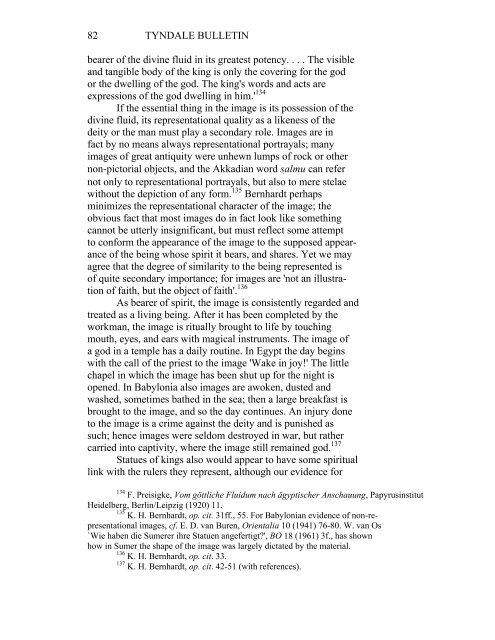THE IMAGE OF GOD IN MAN - Tyndale House
THE IMAGE OF GOD IN MAN - Tyndale House
THE IMAGE OF GOD IN MAN - Tyndale House
- TAGS
- tyndale
- tyndalehouse.com
Create successful ePaper yourself
Turn your PDF publications into a flip-book with our unique Google optimized e-Paper software.
82 TYNDALE BULLET<strong>IN</strong><br />
bearer of the divine fluid in its greatest potency. . . . The visible<br />
and tangible body of the king is only the covering for the god<br />
or the dwelling of the god. The king's words and acts are<br />
expressions of the god dwelling in him.' 134<br />
If the essential thing in the image is its possession of the<br />
divine fluid, its representational quality as a likeness of the<br />
deity or the man must play a secondary role. Images are in<br />
fact by no means always representational portrayals; many<br />
images of great antiquity were unhewn lumps of rock or other<br />
non-pictorial objects, and the Akkadian word ִsalmu can refer<br />
not only to representational portrayals, but also to mere stelae<br />
without the depiction of any form. 135 Bernhardt perhaps<br />
minimizes the representational character of the image; the<br />
obvious fact that most images do in fact look like something<br />
cannot be utterly insignificant, but must reflect some attempt<br />
to conform the appearance of the image to the supposed appear-<br />
ance of the being whose spirit it bears, and shares. Yet we may<br />
agree that the degree of similarity to the being represented is<br />
of quite secondary importance; for images are 'not an illustra-<br />
tion of faith, but the object of faith'. 136<br />
As bearer of spirit, the image is consistently regarded and<br />
treated as a living being. After it has been completed by the<br />
workman, the image is ritually brought to life by touching<br />
mouth, eyes, and ears with magical instruments. The image of<br />
a god in a temple has a daily routine. In Egypt the day begins<br />
with the call of the priest to the image 'Wake in joy!' The little<br />
chapel in which the image has been shut up for the night is<br />
opened. In Babylonia also images are awoken, dusted and<br />
washed, sometimes bathed in the sea; then a large breakfast is<br />
brought to the image, and so the day continues. An injury done<br />
to the image is a crime against the deity and is punished as<br />
such; hence images were seldom destroyed in war, but rather<br />
carried into captivity, where the image still remained god. 137<br />
Statues of kings also would appear to have some spiritual<br />
link with the rulers they represent, although our evidence for<br />
134<br />
F. Preisigke, Vom göttliche Fluidum nach ägyptischer Anschauung, Papyrusinstitut<br />
Heidelberg, Berlin/Leipzig (1920) 11.<br />
135<br />
K. H. Bernhardt, op. cit. 31ff., 55. For Babylonian evidence of non-representational<br />
images, cf. E. D. van Buren, Orientalia 10 (1941) 76-80. W. van Os<br />
`Wie haben die Sumerer ihre Statuen angefertigt?', BO 18 (1961) 3f., has shown<br />
how in Sumer the shape of the image was largely dictated by the material.<br />
136<br />
K. H. Bernhardt, op. cit. 33.<br />
137<br />
K. H. Bernhardt, op. cit. 42-51 (with references).

















